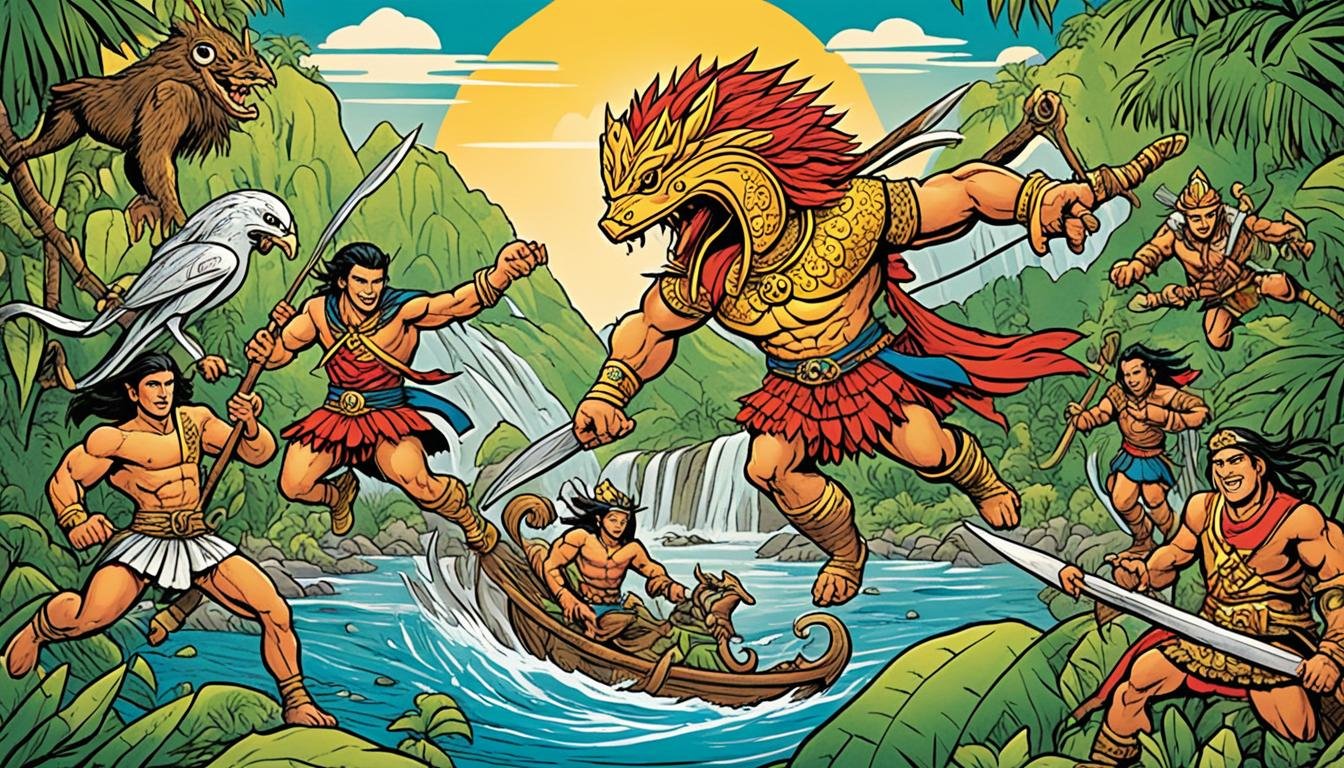For centuries, Filipino myths have woven a rich tapestry of stories. These tales pull from different civilizations and religions, creating a unique cultural mix. The Philippines’ pre-colonial history was marked by Hindu-Buddhist customs, Islamic teachings, and animistic beliefs. This blend created a diverse religious scene across the islands12. Stories of mythical beings, like the Aswang and the kind deity Maria Makiling, remain important in the Philippines today1. Myths from the Anito and Anitism beliefs show a spiritual world before Western influence1. This shows the deep spirituality of the Philippines’ past2.
Key Takeaways
- Indigenous Philippine religions depict a melting pot of mythologies influenced by various ancient civilizations.12
- Pre-colonial myths form a pivotal part of Philippine folk literature, preserving a cultural legacy through story and tradition1.
- The Anitism belief system, encapsulating the term ‘Anito’, played a significant role in shaping cultural and spiritual life in the pre-colonial Philippines1.
- Mythical beings in Filipino folklore, such as Aswang and Maria Makiling, reflect the deep connection and reverence for nature and spirituality1.
- Philippine mythology, rich and complex, is a tapestry of heroic tales, divine narratives, and veneration of the natural world1.
Exploring the World Before Colonization: Unveiling Philippine Mythology
The Philippines has fascinating indigenous religions and Philippine creation myths. These stories include the amazing birth of the first humans from bamboo. They show how important nature is to Filipino culture, especially in Tagalog mythology.
Maranao beliefs also share exciting stories about the universe’s beginning. They honor gods and spirits, showing how life and nature were seen before colonial times. These myths help us understand the worldviews of pre-colonial Filipinos, where many gods existed, much like other cultures around the world.
In 1521, Spanish colonization began to erase these beliefs. Efforts to reclaim these stories have started. Colonizers viewed these myths as ‘barbaric’, undermining women’s roles in society, who were once shamans and leaders3. Myths like the Manananggal were used against women’s freedom3.
Authors Nathalie De Los Santos and IJP Ruiz are working to bring these stories back. They mix old folklore with new insights to reach everyone today. Their work helps us remember the past and feel proud of Philippine folklore3.
Today, ancient wisdom is being remembered and celebrated in the Philippines. This shows the strength of old myths through many years of colonization3.
Decoding the Aswang Myth: From Folklore to Alleged Reality
The aswang folklore is famous in the Philippines as a scary supernatural entity. It comes from ancient stories before the country was a colony. The aswang shows how deeply fear and mystery are part of rural life in the Philippines4.
Aswang: The Shape-shifting Terror
The aswang is known for changing shape, which makes it really scary. It can look like a person or a monster. This ability adds horror and interest, making people wonder about its impact on real life in the Philippines4.
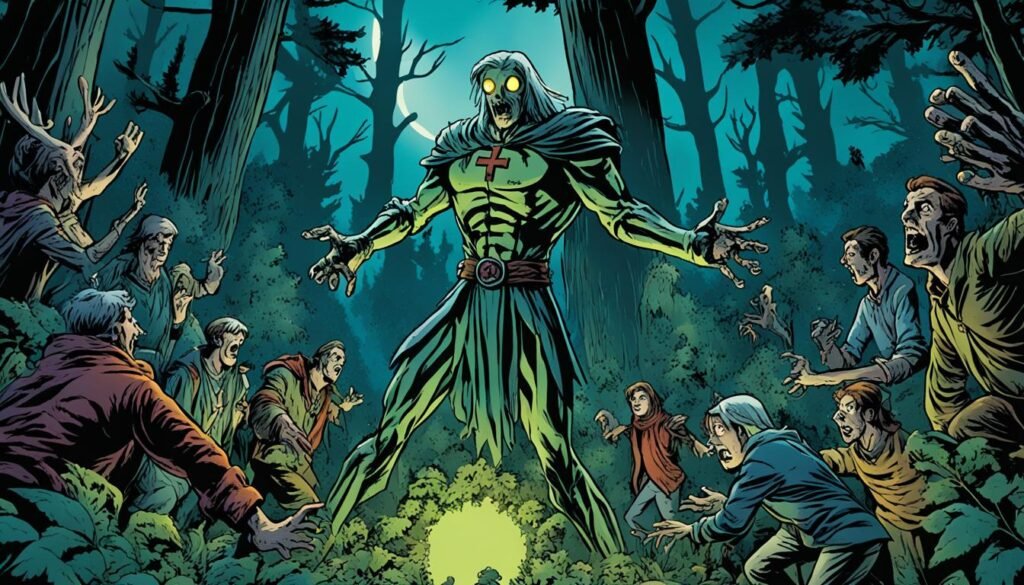
Historical Context and Modern Perceptions
The aswang’s bad reputation grew with changes in culture and stories, especially during Spanish colonial times. The colonizers changed the stories to help control people and spread their religion4. Now, the aswang changes with modern Filipino culture but is still a big part of people’s imagination4.
Media and movies often show the aswang. For example, Lilia Cuntapay became the “Queen of Philippine Horror Movies” starting with “Shake, Rattle & Roll III” in 1991. This helped the aswang become more known in movies4. Events like “Shake, Rattle, and Ball” in Manila’s National Museum of Anthropology keep the aswang stories alive. Exhibits like “Alamat” let artists like Kidlat Tahimik and Leeroy New show their take on the legend4.
Famous people dress up as characters from Philippine legends. Rhian Ramos as Alexandra Trese, Max Collins as the white lady, and Janeena Chan as Ibong Adarna bring these stories to today’s audience4. It shows how old myths are still important now, linking us with our past4.
The aswang is a big part of many festivals, multimedia, and art today. It shows the aswang is more than just a scary story. It is an important symbol of Filipino culture that keeps growing and changing with the times.
The Legendary Being: Maria Makiling as a Symbol of Nature’s Keeper
In the rich lore of the Philippines, the Maria Makiling story shines brightly. This tale combines the physical and spiritual worlds beautifully. Maria Makiling is known as a guardian of Mount Makiling’s lush forests and varied animals5. She stands for ancient Philippine beliefs in nature deities who keep nature and life in harmony5.
The love for Maria Makiling goes beyond tales; it’s part of Filipino identity. People see her as an icon of caring for the environment5. Across Luzon, Visayas, and Mindanao, despite different local spirits, Maria Makiling is cherished for her kind protection5. Her stories, from before Spanish arrival, inspire modern respect for nature.
In Filipino traditions, spirits like Maria Makiling connect to a web of guardian spirits. These spirits are honored with rituals and sacred places, showing how deeply Filipinos feel connected to nature5. This bond with nature is common in Southeast Asia, where ‘Diwata’ comes from Sanskrit, hinting at their heavenly essence5.
Mount Makiling’s name, meaning ‘leaning,’ shows Maria Makiling as a woman lying down. This image emphasizes her role as a protector of nature, and her legend wraps around the mountain’s diverse life5. The Spanish influence is seen in calling her ‘Maria,’ mixing local beliefs with Christianity and making her respected in many stories5.
Looking into Maria Makiling’s tale, we find a story rich with cultural meaning. It reminds us to take care of our planet. Her legend stresses the strength of nature and the spiritual keepers who guard it5.
Understanding the Role of Diwatas and Anitos in Pre-Colonial Society
The Philippines before colonial times was deeply connected to nature and spirituality. This was especially true through the worship of diwatas and anitos. Found in the heart of indigenous Philippine spirituality, these beings shaped many aspects of life. They were key to maintaining balance and harmony in Filipino communities.
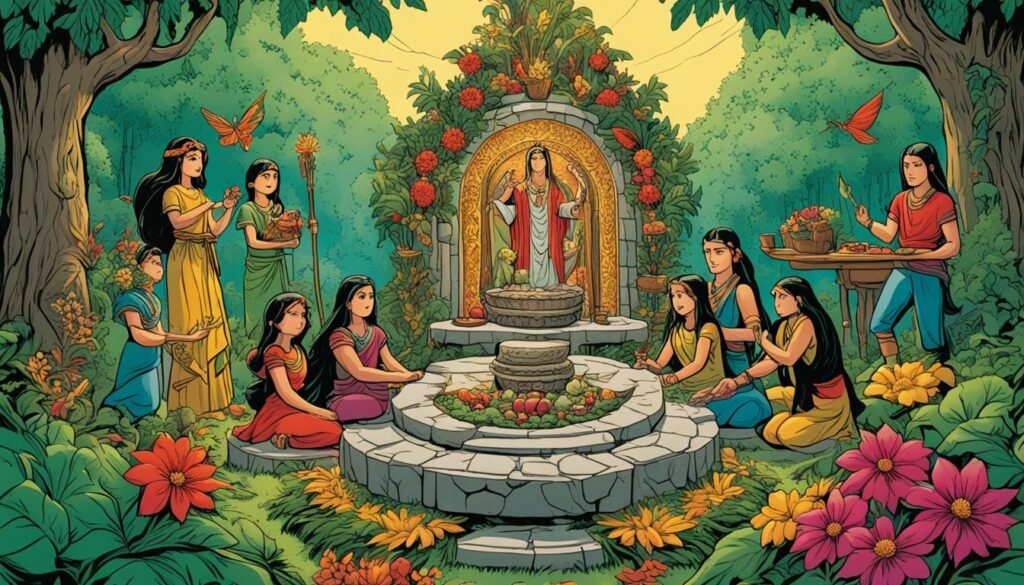
Diwatas: The Enlighteners of Philippine Myth
Research shows diwata worship had a big impact on early Filipinos. They saw these nature spirits as more than just myths but as protectors of the environment6. Rene Villanueva and Joaquin Fernandez highlighted the importance of these goddesses. Their work shows how nature spirits provided wisdom and protection to both land and people6.
Francisco Demetrio’s studies dive deeper into Philippine mythology. They open a window into the pre-colonial mindset that held diwatas in high regard. They played crucial roles in spirituality and everyday life6.
Anitos: The Ancestral Spirits that Influenced Daily Life
The practice of honoring anitos was a key part of Filipino spiritual practices. Anitos were seen as ancestral spirits who provided guidance and blessings. The way Filipinos worshipped anitos shows how they valued the connection with their ancestors.
William Henry Scott’s work throws light on how ancestral worship was part of Filipino life. It shows the lasting influence these practices had on the culture6.
Thanks to history experts like Blair and Robertson, we learn how early Filipinos lived closely with the beliefs in cosmic gods and ancestral spirits. Their work provides a detailed look at the vital role diwatas and anitos played in the pre-colonial spiritual world6.
Philippines Myths: Between Heroic Exploits and Divine Interventions
In the rich tapestry of Philippine epic tales, the valor of mythological heroes and the mystique of divine narratives have always played a key role. These stories have been passed down through generations by word of mouth7. Heroes like Ama-ron and Bernardo Carpio are famed for their extraordinary deeds. Their adventures are mixed with the whims of gods and goddesses, much like the epic poems of other cultures found at Britannica.com7.
Epic poetry has historically inspired warriors, encouraging them to perform heroic deeds. These tales ensured that their victories would be remembered forever. This practice is seen worldwide, from ancient Latin to the Philippine epic tales7. The Fulani epics, like the Filipino stories, were recorded to preserve their cultural legacy7.
The tradition of telling epics orally is strong in the Philippines, lasting as long as the culture itself. In early Greece, the decline of aoidoi gave rise to rhapsodes. These were storytellers who used both memory and sometimes text to share tales7. They played a critical role in keeping these narratives alive for future generations7.
As literacy spread, the method of storytelling evolved, impacting how these stories survived. Written records gave these tales a permanent form. However, if not recorded quickly, the original stories could be lost or changed7. In ancient Greece and other cultures, recitations by singers became public events. This is similar to how Philippine epic tales are shared in village gatherings today7. It’s vital to document these stories to keep the culture true to its roots and knowledge flowing7.
The charm of these myths, from spoken words to written epics, highlights their important place in Filipino culture. Like many countries, the Philippines honors its mythological heroes for their lasting impact on the nation’s identity.
The Enigmatic Bakunawa: A Tale of the Moon Eater
Among Philippine myths, the story of the Bakunawa is special. It tells a story full of cosmic wonder and cultural depth. As a moon-eating dragon from Bisayan/Cebuano folklore, it shows our deep need to understand the night sky’s secrets8.
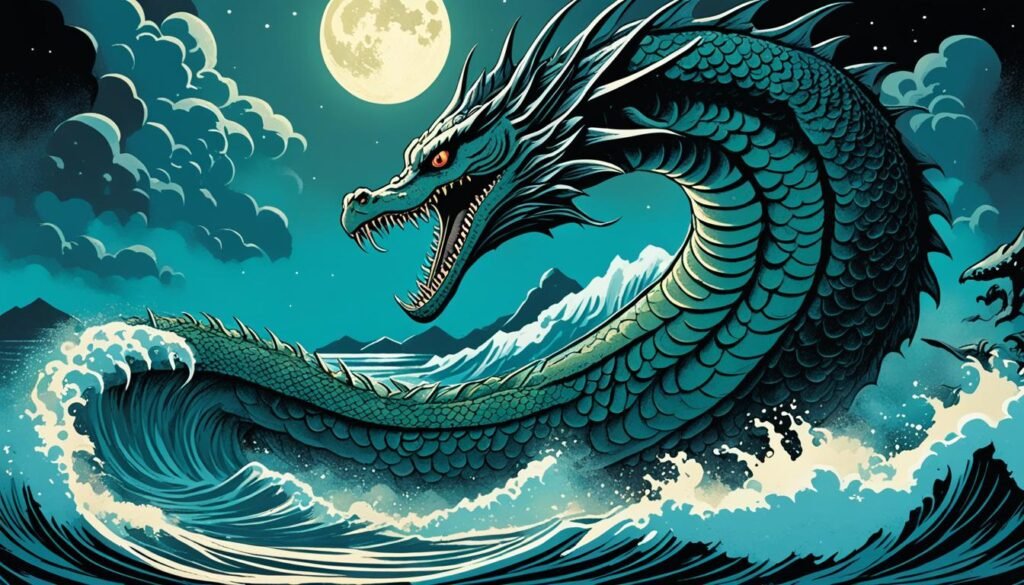
The Seven Moons and the Dragon: An Origin Story
The story of the Bakunawa tells us about a dragon trying to eat the moons. This dragon changed the sky forever, leaving stories full of moonlight and mystery behind. The Philippine sky once had seven moons, shining brightly. The Bakunawa, in its beauty and envy, ate six, one by one, with each disappearing as if refusing to be dominated8.
These stories capture the struggle and awe the early Filipinos felt. They remind us of the beauty and fear that natural events inspired in our ancestors9.
How the Bakunawa Myth Influenced Cultural Traditions
During a lunar eclipse, the Philippines is alive with traditions from the Bakunawa myth. People would beat drums and yell together. They did this to save the last moon from the Bakunawa’s hunger8. This tale explains the lunar eclipse and enriches cultural practices with mythological stories9.
The mysterious story of the Bakunawa and the remaining moon marks Filipino culture deeply. It shows how over 140 ethnic groups in the Philippines weave astronomical events into their rich culture and traditions9.
| Mythological Creature | Role in Folklore | Cultural Significance |
|---|---|---|
| Bakunawa | Moon-eating dragon | Explains lunar eclipses, inspires cultural rituals |
| Diwata | Guardian deities of nature | Represents respect for natural world, guide in stewardship |
| Aswang | Shape-shifting evil creatures | Personifies darker aspects, provides cautionary tales |
| Kapre | Terrifying tree giants | Symbolizes mysterious fears, imparts moral lessons |
| Mangkukulam | Witch or sorcerer casting spells | Manifests societal anxieties, suggests consequences of malice |
Symbols in the Sky: Analyzing Myths of the Celestial Sarimanok
The Sarimanok is not just a story in Philippine culture. It is a fascinating symbol of connection between the earth and the spirit world. This bird, with its eye-catching feathers holding a fish, speaks of wealth and spiritual life. It tells a story of a people touched by different myths from around the world1.
Philippine myths have been around since the 1600s, shared by word of mouth. They mix Hindu, Muslim, and Southeast Asian stories. The Sarimanok is one such tale, blending ideas from different cultures to explain the universe. This mix has deeply affected Philippine culture, making celestial symbols like the Sarimanok meaningful1.
In the Philippines, myths shine even in the stars. Terms like ‘Tagtuyot’ for Lunar Eclipse or ‘Dugong Buwan’ for Blood Moon show how deeply these stories are felt. The Sarimanok moves through these celestial events, linking the Filipino people to the magic in the sky10.
- The Sarimanok’s image serves as a cultural compass in interpreting astral phenomena.
- Its vivid narrative and imagery underscore the Philippines’ rich tradition of astral myth interpretation.
- Symbolically, the Sarimanok connects Filipinos to their ancestral and agricultural deities, affirming the cultural importance of nature and creation within the various regional beliefs111.
The Sarimanok brings more than stories from the sky. It symbolizes wisdom, good fortune, and our connection to the universe. As a mythical bird, it shows how Filipinos see the stars and their place in them. It is a vibrant part of their tradition and quest for meaning111.
Shamanistic Traditions and Rituals in Myth Crafting
In the Philippines, ancient myths and spiritual ways are kept alive. The babaylan, or spiritual leaders, were central in this effort. They bridged the human and spirit worlds, keeping Filipino traditions vibrant amid change.
Babaylans were healers and seers with deep spiritual connections. They used rituals to express their bond with the spirit world.
The Function of Babaylans in Preserving Folklore
Babaylans played many roles, from healing to predicting the future. Folk tales often spoke of the mambabarang, seen both as a healer and a witch. This figure is so revered that in 2015, a company named Alamat Craft Brew introduced a dark beer called “mambabarang,” connecting modern life to ancient stories12.
Today, leaders like Mym Valdez and Inka Magnaye carry on these traditions. They draw from years of shamanistic practices, showing how deep these roots go12.
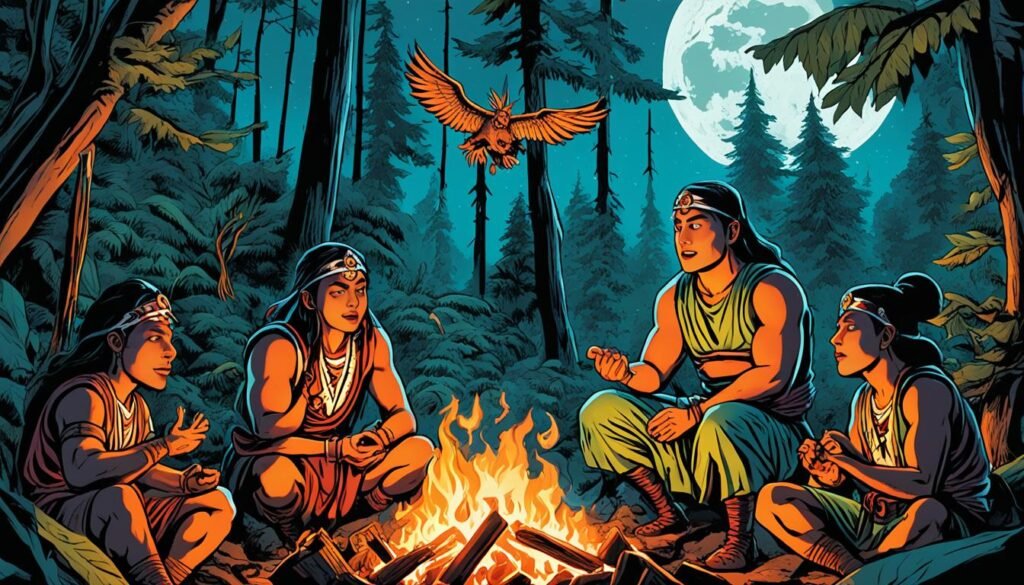
Oral Tradition: Keeping Myths Alive Through Generations
Oral stories have kept Philippine folklore alive. Babaylans enrich this tradition, mixing tales and songs. These stories date back to a time when gods and spirits were central to Filipino beliefs12.
They have been passed down, keeping the ancient shaman spirit alive. This connects people over generations, teaching future ones with past lessons.
The Ifugao people blend old wisdom into today’s life. Even with many converting to Christianity, they keep their animalist beliefs alive. Their world, filled with around 1,500 spirits, remains sacred during their religious events13.
Ifugaos still celebrate with festivals and agricultural rites. Wearable symbols and shared palm liquor ceremonies show a lasting link to their shamanistic origins13. These traditions unite generations, proving stories and customs can withstand time.
The Intertwined Fates of Mythical Animals and Humans According to Lore
Philippine folklore is full of stories about mythical creatures. These beings are seen as both protector spirits and destructive forces. They blur the line between our world and the magical one, affecting how humans and mythical beings interact and shape Philippine folklore.
In the Visayas, legends tell of extraordinary creatures like Basol, Dumorogmon, and Bukaw. These creatures are not just stories but influence local customs and beliefs14. Even real animals like the Basol caterpillar are given magical qualities, becoming a part of the myths14.
Mythical Beasts: Protector or Destroyer
These mythical beings represent the delicate balance between humans and the supernatural. The indigenous peoples of the Philippines saw birds like Kiling and Kumpisaw as signs for farming. They trusted these birds’ behaviors to guide their agricultural activities, showing how closely humans and mystical beings are connected14.
Human Interaction with Mythical Creatures: A Relationship of Respect and Fear
Different groups in the Philippines looked up to bird omens like Balatiti, Haya, and others for making decisions. These bird omens and beings like the speaking Almugan bird and the Pulajan Barometer show a deep bond with the supernatural world14. Supernatural plants, such as the Banana tree and Takang Demonio, were important for both practical and mystical reasons, highlighting the close relationship between people and mythology in the Philippines14.
Exploring these myths reminds us of their huge impact on society, customs, and how we view the environment. The way people relate to these mythical beings is based on both respect and fear. This shows the lasting power of folklore and encourages us to look deeper into human interactions with the unseen world.
> Visayan Bestiary and supernatural beliefs
Revisiting The Ancient Epic Tales and Their Lasting Influence
Philippine epic tales give us a peek into the nation’s cultural heritage. They show the essence and spirit via indigenous storytelling. These epic narratives live on, not just in stories, but in actions that carry their legacy. In 2009, Jake Verzosa captured the Kalinga women elders, including Whang-Od who is now 106. His photos show their significant place in Philippine culture15.
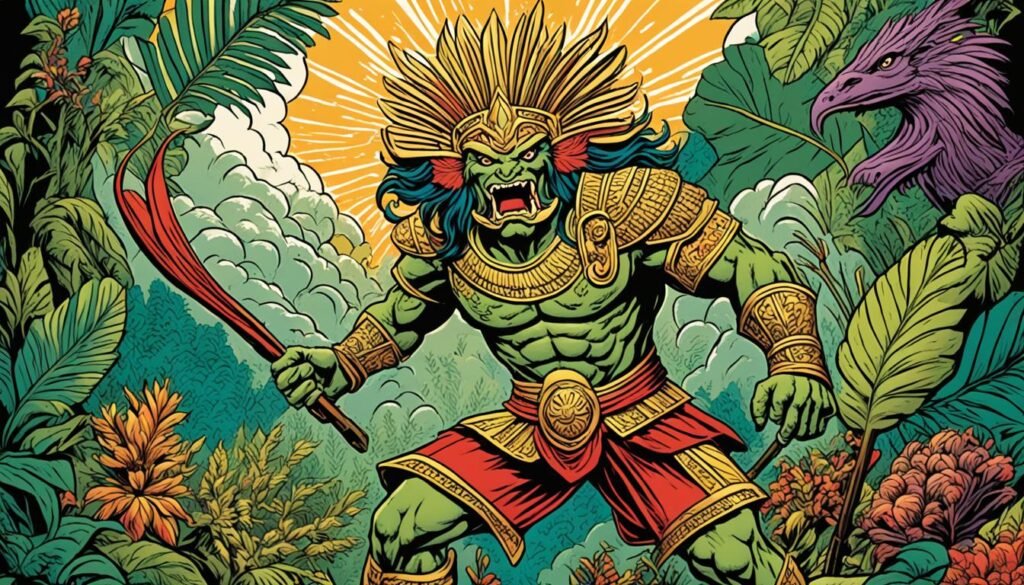
The batok’s journey from traditional to global is led by people like Lane Wilcken and Natalia Roxas15. They help Filipino Americans reconnect with their roots. Piper Abas is reviving Visayan and Mindanao tattoo traditions. This keeps these ancient arts alive15. Their work shows a growing trend. More Filipinos now embrace indigenous tattoos as a way to decolonize beauty standards15.
Dr. Analyn Salvador-Amores offers insights into how cultural practices are becoming commercial. She encourages us to think about their true meaning and role today15. This balance of keeping and evolving epic narratives shapes Philippine cultural heritage. The revival in indigenous storytelling, seen in Kalinga tattoos, shows a strong connection to Filipino identity and pride. This is true for Filipinos everywhere15.
Kan Laon: The Supreme Deity in Visayan Mythology
In Visayan mythology, Kan Laon deity stands as the revered supreme being1. As the goddess of harvest, she plays a crucial role in the life of Visayas’ people, nurturing the land and its people1. The stories of Kan Laon showcase a blend of Austronesian, Hindu, and Islamic influences, showing the richness of Philippine mythological stories that have been shared for generations1.
Kan Laon is seen as the Tagalog deity Bathala’s counterpart, taking on roles beyond just an agricultural goddess1. She represents both the unity and diversity found in Filipino myths. These myths highlight common themes of supreme beings despite regional differences1.
Laon: Goddess of Harvest and Her Place in Agrarian Society
Laon is deeply respected within the agricultural community, influencing the outcome of crops and weather1. Despite Spanish colonization efforts, her worship has persisted, showing the strong bond between people and the agricultural goddess1.
Deconstructing the Image of Kan Laon: Warrior, Ruler, and Creator
Kan Laon is often seen as a warrior and ruler, serving as a creator god who ensures justice and balance1. Even before colonial times, her stories were kept alive in oral traditions, keeping Visayan mythology vibrant1. With roles varying from a powerful force of nature to a benevolent provider, Kan Laon’s image in Philippine mythology shows the depth and intrigue of deified rulers. These stories continue to captivate, especially young people, across various platforms1.
Myth or Reality: The Influence of Pre-Colonial Beliefs in Contemporary Philippines
The mythological influence of early Philippines shows how deep Filipino spirituality runs. Even after hundreds of years of foreign rule, the imprint of pre-colonial beliefs is still clear in today’s Philippines. The Spanish tried to erase local myths but ended up mixing them with Roman Catholic beliefs instead3.
Colonizers used Filipino folklore to control the people. The Americans, taking over from the Spanish, used local myths against Filipino rebels. They made rebels appear cursed by Aswang to spread fear3. However, Filipinos are now reclaiming their mythology. Through their work, modern Filipino artists are taking back their culture and rewriting colonial narratives. Taking back the monsters of Filipino folklore allows Filipinos to assert their identity3.
Colonialism also changed how society sees women and indigenous beliefs. For example, stories about the Manananggal demonized female figures. Such tales show how colonialism split the view of different beliefs in the Philippines3. Yet, old beliefs still shape Filipino life. They prove that these myths are not dead but an active part of the nation’s soul.
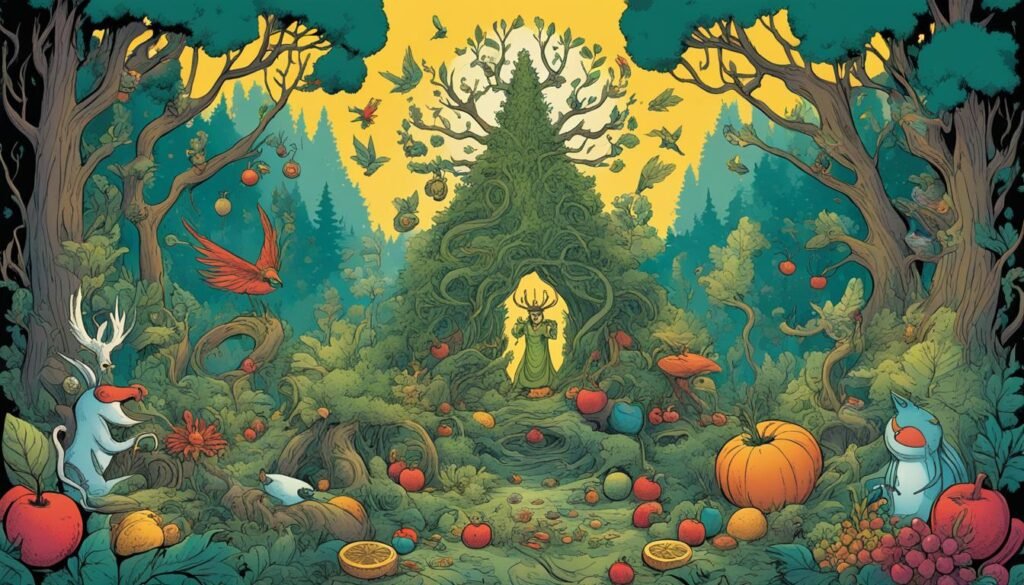
Now, Filipinos are reconnecting with their ancient tales. This renewal shows a nation merging its history with the present. The strong presence of pre-colonial beliefs in today’s culture highlights the importance of heritage.3
Conclusion
In the heart of Philippine mythology, vibrant tales unfold under the warm sun. These stories are not just folklore. They reflect the ancestral wisdom and beliefs of the nation. From Bathala, the supreme sun god, to Bakunawa, the “Moon eater,” these legends have shaped the beliefs and society of the Filipinos for ages16. Tales of heroes like Apolaki and the peaceful rule of Mayari show a mythical balance between day and night16.
The legends also touch on health and understanding nature. The link between cultural legacy and modern life shines across the 7,107 islands of the Philippines17. Through stories of creatures like the Aswang, Filipinos have expressed their fears and hopes18. Even as times change, these myths remain central to Filipino identity and views on health and well-being, affecting daily life1817.
These magical and educational stories keep resonating, keeping the nation’s identity strong. They show the lasting impact of Philippine mythology, blending ancient traditions with the present. This fusion makes it a key part of the Filipino spirit and a precious part of their heritage161817.
FAQ
What is the significance of Filipino folklore and pre-colonial myths in Philippine folk literature?
Filipino folklore and pre-colonial myths show us the beliefs and cultures in the Philippines before other countries influenced them. They reveal the early Filipinos’ values and traditions. These stories still shape Filipino culture today.
How do Philippine creation myths explain the origins of the world in indigenous religions?
In the Philippines, each ethnic group, like the Tagalog and Maranao, has its own creation myth. These stories talk about gods, the sky, and nature to explain how the world began. They are key to understanding the world and human life for these cultures.
Who are the aswang and why are they significant in Philippine folklore?
The aswang are spooky beings that change shape in Philippine stories. They bring fear in rural places. These tales show how Filipinos see fear and the unknown. Aswang stories have changed over time with new influences.
What does the Maria Makiling myth symbolize in Philippine culture?
The Maria Makiling story shows how important nature is in Philippine culture before other influences. She is a guardian of nature, reminding Filipinos to take care of the environment. This myth underlines the bond between Filipinos and nature.
Can you explain the role of diwatas and anitos in indigenous Philippine spirituality?
In Philippine beliefs, diwatas are like gods or spirits that look after nature and people. Anitos are spirits of ancestors who are honored in special ceremonies. Both are central in Filipino traditions, guiding their way of life and beliefs.
How do mythological heroes and divine narratives shape Philippine epic tales?
Heroes and divine stories are at the heart of Philippine epics. Stories about Ama-ron and Bernardo Carpio teach bravery, adventure, and right and wrong. These tales help keep Filipino identity and traditions alive.
What is the Bakunawa myth, and how has it affected Filipino cultural traditions?
The Bakunawa myth is about a dragon that tries to eat the moons. It has shaped Filipino traditions, especially during lunar eclipses. People perform rituals to stop the dragon from eating the moon.
What does the Sarimanok symbolize in Philippine mythology?
The Sarimanok in Philippine myths stands for luck, purity, and the bridge between earth and the spirit world. It’s shown as a colorful bird with a fish, carrying messages from gods to people.
What is the purpose of babaylans in the context of Philippine folklore?
Babaylans were spiritual leaders in the Philippines. They kept folklore alive, led ceremonies, and healed people spiritually. They helped pass down stories and traditions, keeping the culture strong.
How are human interactions with mythical creatures depicted in Philippine folklore?
In Philippine stories, people and mythical beings interact with both respect and fear. Beings like the Kapre protect, while others, like the Tiyanak, bring harm. These stories show the balance needed between humans and the supernatural.
Who is Kan Laon, and what is her significance in Visayan mythology?
Kan Laon, or Lalahon, is a major goddess in Visayan myths, like Bathala to the Tagalogs. She’s seen as a harvest goddess and a warrior. Her role is very important in both farming and spiritual practices in the Visayas.
How do pre-colonial beliefs influence the contemporary Philippines?
Old beliefs shape modern Filipino life through festivals, daily practices, and stories. These traditions have mixed into today’s Filipino culture, showing how it has grown and changed over time.
Source Links
- https://en.wikipedia.org/wiki/Philippine_mythology
- https://www.ancient-origins.net/ancient-places-asia/pre-colonial-philippines-0010781
- https://www.cbc.ca/news/canada/british-columbia/b-c-authors-are-taking-back-the-monsters-of-filipino-folklore-from-colonial-influences-1.6077657
- https://republicasiamedia.com/celebrities-honor-ph-folklore-at-shake-rattle-and-ball/
- https://www.aswangproject.com/diwata/
- https://www.sanbeda.edu.ph/uploads/files/1563862716_Stewardship_Towards_God’s_Creation.pdf
- https://www.britannica.com/art/epic
- https://www.philippineartscouncil.com/post/bakunawa
- https://en.wikipedia.org/wiki/List_of_Philippine_mythological_creatures
- https://fluentfilipino.com/space-and-the-universe-filipino-vocabulary-expansion/
- https://hunterswoodsph.com/philippine-mythology-gods/
- https://www.scmp.com/lifestyle/travel-leisure/article/2184111/witchcraft-philippines-millennials-fall-under-spell
- https://factsanddetails.com/southeast-asia/Philippines/sub5_6d/entry-3880.html
- https://www.aswangproject.com/strange-beasts-trees-philippines/
- https://www.vogue.com/article/apo-whang-od-and-the-indelible-marks-of-filipino-identity
- https://www.wowessays.com/free-samples/free-essay-about-the-philippiness-cultural-mythology/
- https://www.ncbi.nlm.nih.gov/pmc/articles/PMC4159471/
- https://journal.usep.edu.ph/index.php/Southeastern_Philippines_Journal/article/download/143/69/

